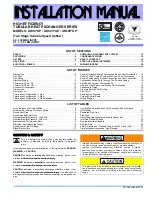
SYSTEM OPERATION
15
• If the average calculated duty cycle is 50% or greater,
then the heating cycle will be treated as if high stage
is needed and the transition from low to high stage
delay will happen quickly. In this case an assumption
is made that the outside temperature is cold and that
the thermostat is likely coming out of setback. Since
assumptions are being made during this heating cycle
the duty cycle for this heat cycle will not be used in
the average calculated duty cycle formula for future
heating cycles.
•
The duty cycle is calculated every cycle and used
during the next cycle. The equation for the duty cycle
is calculated as follows: Duty Cycle = (Time the ap
-
propriate stage is ON) / (Time of the complete cycle).
•
The average calculated duty cycle is determined
by averaging the previous average calculated duty
cycle with the duty cycle from the previous cycle.
This places a large emphasis on the previous cycle
but allows a large variation in any one duty cycle to
be averaged out after just a few complete heating
cycles.
• If there is no load activity for 24 hours or more then
set the Duty Cycle = 100%
• The initial default average calculated duty cycle = 50%
Duty Cycle %
Valve Output
Demand
0-38
1
st
Stage, 12 minute 2
nd
Stage
Light
38-50
1
st
Stage, 10 minute 2
nd
Stage Light to Average
50-62
1
st
Stage, 7 minute 2
nd
Stage
Average
62-75
1
st
Stage, 5 minute 2
nd
Stage Average to Heavy
75-88
1
st
Stage, 3 minute 2
nd
Stage
Heavy
88-100
1
st
Stage, 1 minute 2
nd
Stage
Heavy
1
2
3
4
90
OFF
OFF
120
OFF
ON
150
ON*
OFF*
180
ON
ON
*Factory Setting
Blower Off Delay Dip Switches PCBBF139
Heating Fan Off
Delay
S3
Dip Switch
Purpose
Switch Group
Function
Heat Mode Blower Off Delay Timing
COOLING MODE:
LOW STAGE COOLING MODE SEQUENCE:
•
On a call for lo cool, the Ylo and G thermostat contacts
close signaling the control module.
• The LED will display a “GREEN”1 flash
•
The compressor and condenser fan are energized.
The compressor is connected to the Ylo terminal of
the control module.
•
The circulator fan is energized at lo cool speed after
a cool on delay. The electronic air cleaner will also
be energized.
• After the thermostat is satisfied, the compressor is
de-energized
• Following the 60 second Cool Mode Fan Off Delay
period, the cool circulator and air cleaner relay are
de-energized.
•
When the call for “Ylo”and “G”are presented simul
-
taneously, the control will honor the Cool On delay
and keep the circulator de-energized. After the Cool
On delay, the circulator fan and air cleaner relays
are energized. The circulator fan is energized at the
cool speed. If a call for “G”is present prior to a call for
“Ylo”, the circulator will remain at the FAN circulator
speed during the Cool On delay.
SINGLE COOLING STAGE THERMOSTAT OR 2ND
STAGE COOLING MODE SEQUENCE.
• On a call for cool, the Y and G thermostat contacts
close signaling the control module.
• The LED will display a “GREEN”2 flash
•
The compressor and condenser fan are energized.
The compressor is connected to the Y terminal of
the control module.
• The circulator fan is energized at cool speed after a
cool on delay. The electronic air cleaner will also be
energized.
• After the thermostat is satisfied, the compressor
is de-energized and the Cool Mode FanOff Delay
period begins.
• Following the 60 second Cool Mode Fan Off Delay
period, the cool circulator and air cleaner relay are
de-energized
MANUAL FAN ON:
•
On a call for Fan, the G thermostat contacts close
signaling the control module.
• The LED will display a solid “GREEN”
• When a call for G is received, the control will energize
the circulator in low heat speed after the fan on delay
time expires. The electronic air cleaner will also be
energized at this time.
• When the thermostat fan switch is moved to the ON
position, the circulator blower is energized at low heat
speed and the electronic air cleaner is also energized
• When the thermostat fan switch is moved back to
the AUTO position, the circulator fan and air clean
-
er relay are de-energized and the control awaits a
thermostat call for heat or cool.
• Exception: During the Cool “On”delay, the control
will not respond to the fan input. If the fan was called
prior to the call for cool, the circulator will remain
energized during the Cool “On”delay.
• If the fan is called prior to a call for heat, the circulator
will remain energized during the entire call for heat
sequence.







































